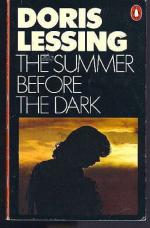|
This section contains 4,712 words (approx. 16 pages at 300 words per page) |

|
SOURCE: Hotchkiss, Jane. “Coming of Age in Zambesia.” In Borders, Exiles, Diasporas, edited by Elazar Barkan and Marie-Denise Shelton, pp. 81-91. Stanford, CA: Stanford University Press, 1998.
In the following essay, Hotchkiss provides a stylistic and thematic analysis of Lessing's African stories.
When Doris Lessing's collection of African stories first appeared in 1951, white South African reviews revealed the peculiar double vision of colonial settlers. Her sketches of Southern African societies were applauded for their realism, yet the urgent issues they raised were left lying, as if inert, and the urgency was evaluated as a “bitterness” that spoiled her “art.” Lessing's work was often regretfully dismissed as “promising but artistically flawed” by her tendency to “standardiz[e] human beings to serve abstract ideas.” Her brief return to Africa in 1956 elicited a sharper response. Journalist Oliver Walker confidently claimed, in an article ominously titled “Novelist Given a Tarred White Feather in...
|
This section contains 4,712 words (approx. 16 pages at 300 words per page) |

|


